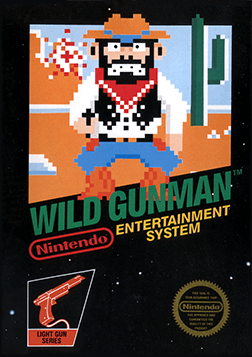Wild Gunman
| Wild Gunman | |
|---|---|
 | |
| Developer(s) | Nintendo R&D1 Intelligent Systems |
| Publisher(s) | Nintendo |
| Producer(s) | Hiroshi Imanishi |
| Composer(s) | Hirokazu Tanaka |
| Platform(s) | Nintendo Entertainment System, PlayChoice-10 |
| Release date(s) |
|
| Genre(s) | Light gun game |
| Mode(s) | Single-player |
| Distribution | 256-kilobit cartridge |
Wild Gunman (ワイルドガンマン Wairudo Ganman) is a light gun shooter game created by Nintendo.
Early version
The original version of Wild Gunman was one of Nintendo's electro-mechanical arcade games created by Gunpei Yokoi and released in 1974. It consisted of a light gun connected to a 16mm projection screen. Full-motion video footage of a Wild West gunslinger was projected onto the screen and when his eyes flashed, the player needed to draw and shoot. If the player was fast enough, the projection would change to that of the shot gunman falling down, otherwise it would show the gunman drawing and firing his gun. If the player won, then they would face off against several more gunslinger opponents.[1]
The second version had a plastic gunman figure mounted on top of a plastic battery box called Custom Gunman, which later became one of the microgames in the Game Boy Advance title, WarioWare, Inc.: Mega Microgames!
Video game

An updated video game version of the game, replacing photographic images with cartoon-style video game sprites, was released for Famicom in 1984 and the Nintendo Entertainment System in 1985.
In this version, the player also waited for the opponent's eyes to flash (accompanied by a speech bubble reading "FIRE!!") before shooting. It also featured a shooting gallery where opponents had to be shot from the windows of a saloon. A piece of Frédéric Chopin's "Funeral march" indicates the player's defeat.
It was also available on the PlayChoice-10 arcade system, as portrayed in the movie Back to the Future Part II. The Famicom version for use with the Zapper peripheral was released in Japan the same year, and in the United States on the Nintendo Entertainment System in 1985. The Famicom version was also available packaged with a plastic, western-style revolver accessory (modelled after the Colt Single Action Army) that could be used instead of the Zapper.
In media
Experimental filmmaker Craig Baldwin's 1978 short Wild Gunman features footage from the original 1974 video game re-edited, sped up and slowed down to surreal effect.[2] The game also appeared briefly as an arcade machine in Back to the Future Part II.
See also
References
External links
- Wild Gunman series at NinDB
- Wild Gunman Arcade Prop Replica at KLOV
- Front and Back side of the flyer of the original 1974 Wild Gunman movie game (from Arcade Flyer Archive) as well as two pictures #1 and #2 of this version (from an AOL member homepage).